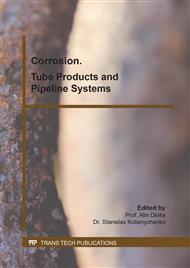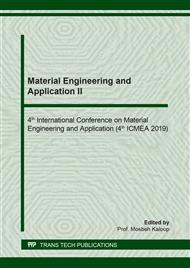[1]
D. H. Kang, J. K. Lee, T. W. Kim, Corrosion Fatigue Crack Propagation of High-strength Steel HSB800 in a seawater environment, Procedia Eng. 10 (2011) 1170-1175.
DOI: 10.1016/j.proeng.2011.04.195
Google Scholar
[2]
A. Cheng, N. Z. Chen, Corrosion fatigue crack growth modelling for subsea pipeline steels, Ocean Eng. 142 (2017) 10-19.
DOI: 10.1016/j.oceaneng.2017.06.057
Google Scholar
[3]
A. Cheng, N. Z. Chen, An extended engineering critical assessment for corrosion fatigue of subsea pipeline steels, Eng. Failure Anal. 84 (2018) 262-275.
DOI: 10.1016/j.engfailanal.2017.11.012
Google Scholar
[4]
J. L. Otegui, H. W. Kerr, D. J. Burns, U. H. Mohaupt, Fatigue crack initiation from defects at weld toes in steel, Int. J. Pressure Vessels Piping. 38(5) (1989) 385-417.
DOI: 10.1016/0308-0161(89)90048-3
Google Scholar
[5]
M. Madia, B. Schork, J. Bernhard, M. Kaffenberger, Multiple crack initiation and propagation in weldments under fatigue loading, Procedia Structural Integrity. 7 (2017) 423-430.
DOI: 10.1016/j.prostr.2017.11.108
Google Scholar
[6]
R. Murakami, W. G. Ferguson, The Effects of Cathodic Potential and Calcareous Deposits on Corrosion Fatigue Crack Growth Rate in Sea Water for Two Offshore Structural Steels, Fatigue Fracture Eng. Mater. Struct. 9(6) (1987) 477-488.
DOI: 10.1111/j.1460-2695.1987.tb00472.x
Google Scholar
[7]
M. Knop, J. Heath, Z. Sterjovski, S. P. Lynch, Effects of cycle frequency on corrosion-fatigue crack growth in cathodically protected high-strength steels, Procedia Eng. 2(1) (2010) 1243-1252.
DOI: 10.1016/j.proeng.2010.03.135
Google Scholar
[8]
M. Cabrini, S. Lorenzi, T. Pastore, D. P. Bucella, Hydrogen diffusion in low alloy steels under cyclic loading, Corros Rev. 37(5) (2019) 459-467.
DOI: 10.1515/corrrev-2019-0008
Google Scholar
[9]
M. Cabrini, T. Pastore, Hydrogen diffusion and EAC of pipeline steels under cathodic protection, Frac. Nano Eng. Mater. Stru. (16th European Conference of Fracture, Alexandropulis, Greece). (2006) 1005-1006.
DOI: 10.1007/1-4020-4972-2_498
Google Scholar
[10]
M. Cabrini, S. Lorenzi, P. Marcassoli, T. Pastore, Effect of hydrogen diffusion on environmental assisted cracking of pipeline steels under cathodic protection, La Metallurgia Italiana. 100(2) (2008) 15-22.
Google Scholar
[11]
L. Barsanti, F. M. Bolzoni, M. Cabrini, T. Pastore, C. Spinelli, Hydrogen-embrittlement resistance of X100 steels for long-distance high-pressure pipelines, Environ. -Induced Cracking Mater. 2 ( 2008) 291-301.
DOI: 10.1016/b978-008044635-6.50066-2
Google Scholar
[12]
M. Cabrini, S. Lorenzi, S. Pellegrini, T. Pastore, Environmentally assisted cracking and hydrogen diffusion in traditional and high-strength pipeline steels, Corr. Rev. 33(6) (2015) 529-545.
DOI: 10.1515/corrrev-2015-0051
Google Scholar
[13]
D. Hardie, E. A. Charles, A. H. Lopez, Hydrogen embrittlement of high strength pipeline steels, Corr. Sci. 48(12) (2006) 4378-4385.
DOI: 10.1016/j.corsci.2006.02.011
Google Scholar
[14]
T. Zhang, W. Zhao, T. Li, Y. Zhao, Q. Deng, Y. Wang, W. Jiang, Comparison of hydrogen embrittlement susceptibility of three cathodic protected subsea pipeline steels from a point of view of hydrogen permeation, Corr. Sci. 131 (2018) 104-115.
DOI: 10.1016/j.corsci.2017.11.013
Google Scholar
[15]
S. Lorenzi, T. Pastore, T. Bellezze, R. Fratesi, Cathodic protection modelling of a propeller shaft, Corr. Sci. 108 (2016) 36-46.
DOI: 10.1016/j.corsci.2016.02.035
Google Scholar
[16]
S.A. Shipilov, L. L. May, Structural integrity of aging buried pipelines having cathodic protection, Eng. Failure Anal. 13(7) (2006) 1159-1176.
DOI: 10.1016/j.engfailanal.2005.07.008
Google Scholar
[17]
S. Eliassen, New concept for cathodic protection of offshore pipelines to reduce hydrogen induced stress cracking (HISC) in high strength 13%Cr stainless steels, Corr. Eng. Sci. Tech. 39(1) (2004) 31-37.
DOI: 10.1179/147842204225016868
Google Scholar
[18]
M. E. Orazem, J. M. Esteban, K. J. Kennelley, R. M. Degerstedt, Mathematical Models for Cathodic Protection of an Underground Pipeline with Coating Holidays: Part 1 Theoretical Development, Corr. Sci. 53(4) (1997) 264-272.
DOI: 10.5006/1.3280467
Google Scholar
[19]
B. Bazzoni, S. Lorenzi, P. Marcassoli, T. Pastore, Current and potential distribution modeling for cathodic protection of tank bottoms, Corrosion. 67(2) (2011).
DOI: 10.5006/1.3553930
Google Scholar
[20]
G. Demofonti, M. Cabrini, F. Marchesani, C. Spinelli, Eni Tap Project Mechanical Damage and Environmental Assisted Cracking -Full Scale Methodology Overview, John Wiley & Sons. (2008) 611-624.
Google Scholar
[21]
A. Punter, A. T. Fikkers, G. Vanstaen, Hydrogen-Induced Stress Corrosion Cracking on a Pipeline, Mater. Perform. 31(6) (1992) 24-28.
Google Scholar
[22]
M. Cabrini, G. D'Urso, T. Pastore, Evaluation Of The Resistance To Hydrogen Embrittlement By Slow Bending Test, Environ. -Induced Cracking Mater. 2 (2008) 493-502.
DOI: 10.1016/b978-008044635-6.50085-6
Google Scholar
[23]
P. Fassina, F. M. Bolzoni, G. Fumagalli, L. Lazzari, L. Vergani, A. Sciuccati, Influence of hydrogen and low temperature on mechanical behaviour of two pipeline steels, Eng. Fract. Mech. 81 (2012) 43-55.
DOI: 10.1016/j.engfracmech.2011.09.016
Google Scholar
[24]
R. Wang, Effects of hydrogen on the fracture toughness of a X70 pipeline steel, Corr. Sci. 51(12) (2009) 2803-2810.
DOI: 10.1016/j.corsci.2009.07.013
Google Scholar
[25]
M. Cabrini, E. Sinigaglia, C. M. Spinelli, M. Tarenzi, C. Testa, F. M. Bolzoni, Hydrogen Embrittlement Evaluation of Micro Alloyed Steels by Means of J-Integral Curve, Materials 2019. 12(11) 1843.
DOI: 10.3390/ma12111843
Google Scholar



